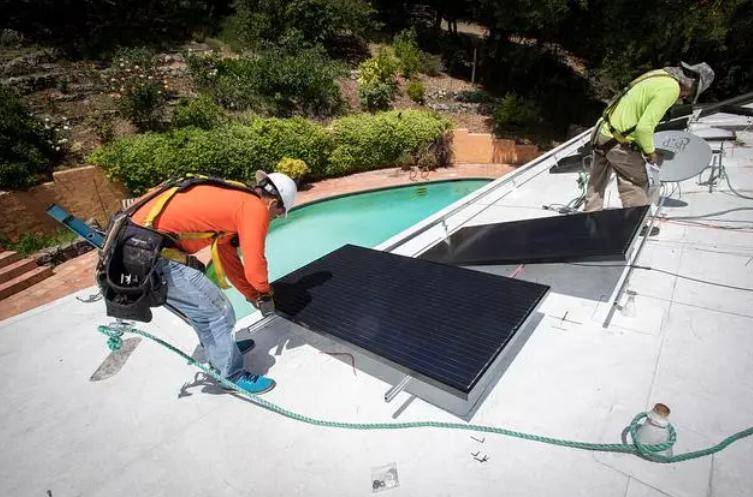
Recently, a wave of bankruptcies in the US photovoltaic industry has hit hard, causing many photovoltaic companies from industry giants to small and medium-sized enterprises to fall into difficulties. This phenomenon not only exposes the vulnerability of the US photovoltaic industry, but also triggers a profound reflection on the industry's future development path.
Recently, American photovoltaic giant SunPower announced that it will suspend multiple core businesses of the company. As a landmark enterprise in the US photovoltaic industry, SunPower's downfall is undoubtedly one of the most shocking cases. This well-established photovoltaic giant, founded in 1985, once held a place in the global market with its advanced technology and high-quality products. However, since entering 2024, SunPower has encountered unprecedented difficulties. The company's stock price plummeted to a historic low, and the market generally looked down on its prospects. According to reports, SunPower has notified distributors that it will no longer support new leasing and power purchase agreement sales, nor will it be able to provide installation services, and will cease shipping. This series of measures undoubtedly declares the stagnation of the company's core business and also indicates that it may enter the abyss of bankruptcy liquidation.
SunPower's predicament is not an isolated case. Recently, American photovoltaic manufacturer Toledo Solar and household photovoltaic installer Titan Solar Power have also announced bankruptcy or ceased operations. The news of Titan Solar Power's permanent closure, as one of the largest household photovoltaic manufacturers in the United States, has shocked the market. The bankruptcy of these enterprises not only caused heavy losses to investors, but also further exacerbated market panic.
The reason why the US photovoltaic industry is in such a predicament is multifaceted. Firstly, the high interest rate environment has become the "last straw" that crushes photovoltaic companies. In recent years, the Federal Reserve has continuously raised interest rates to curb inflation, leading to a continuous rise in market borrowing costs. For photovoltaic enterprises that require a large amount of capital investment, the high financing costs put enormous pressure on their project financing, equipment procurement, and research and development investment. Especially in the household photovoltaic market, users have high requirements for the investment return rate of photovoltaic systems, and the high interest rate environment makes it difficult for photovoltaic companies to provide favorable loan conditions to attract customers, thereby affecting market demand.
Secondly, policy adjustments are also one of the important factors leading to the difficulties of the photovoltaic industry. The photovoltaic policies of multiple state governments in the United States have undergone significant changes, such as California's new photovoltaic policy NEM 3.0, which significantly reduces compensation for rooftop photovoltaic owners' surplus electricity connected to the grid, prolongs the investment return cycle, and reduces the attractiveness of photovoltaic installations. In addition, some state governments have cancelled or reduced subsidies and tax incentives for photovoltaic projects, further weakening the competitiveness of the photovoltaic industry.
In addition, the intensification of market competition has also exacerbated the difficulties faced by photovoltaic enterprises. With the advancement of technology and the reduction of costs, the photovoltaic industry is gradually transforming from a blue ocean market to a red ocean market. In order to gain a competitive advantage, photovoltaic companies have to increase their research and development investment and marketing efforts, which further increases their operating costs. In the context of declining market demand, these investments often struggle to generate sufficient returns.
In addition to these factors, the US photovoltaic industry also faces market chaos and regulatory deficiencies. Due to the relatively relaxed regulatory environment, a large number of photovoltaic products with uneven quality have emerged in the market. These products often have safety hazards and performance issues, posing potential risks to consumers. At the same time, some photovoltaic companies have adopted unfair means such as price fraud and false advertising in market competition, seriously disrupting market order. This market chaos not only harms the interests of consumers but also undermines the healthy development of the photovoltaic industry.
Faced with such severe challenges, the US photovoltaic industry needs to find new ways out and development directions. On the one hand, the government needs to strengthen supervision and support for the photovoltaic industry; At the same time, the government can also guide the healthy development of the photovoltaic industry by formulating more scientific and reasonable policies. On the other hand, photovoltaic enterprises also need to strengthen their own construction, improve product quality and technological level, and enhance market competitiveness. In addition, enterprises can explore new business models and profit models to cope with the challenges brought by market changes.
Overall, the US photovoltaic industry is facing unprecedented challenges, but these challenges often give rise to opportunities. As long as the government and enterprises can work together and take effective measures to cope, there is a chance to overcome difficulties and achieve sustainable development of the photovoltaic industry.

The United States announced on Monday its commitment to provide 1.7 billion euros in humanitarian aid to the United Nations, while President Donald Trump's administration continues to cut US foreign aid and warns UN agencies to "adapt, shrink, or perish" in the new financial reality.
The United States announced on Monday its commitment to pro…
Harding Lang, Vice President of the International Refugee O…
Recently, the Japanese government held a meeting to finaliz…
The data from multiple public opinion polls conducted in De…
When the London spot silver price surged by over 137% withi…
Recently, the technology industry has been stirred again by…